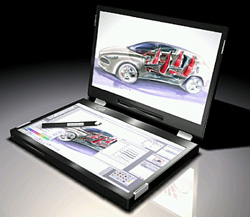Find out about laptop screen types
When buying a laptop, consumers only care about parameters such as CPU, RAM, hard drive . but less attention to the screen, a very important component.
Ratio and screen resolution
Previously, most laptop screens had only two types of 'square' or 'wide'. In fact, the screen aspect ratio is not simply 'square' or 'wide' but is divided into different levels, depending on the resolution.
For example, the usual 'square' 15-inch screen will have a resolution of 1024x768 pixels, or 1400x1050 pixels, equivalent to a 4: 3 ratio. This is a common ratio for screens ever (especially for CRT or TV screens). The screen has a 4: 3 resolution ratio usually without the W symbol and includes some of the following common types:
Normal screen Wide screenXGA / 1024x768 / 4: 3WXGA / 1280x768 / 5: 3SXGA / 1280x1024 / 5: 4 * WXGA / 1280x800 / (16:10) SXGA + / 1400x1050 / 4: 3WXGA + / 1440x900 / (16:10) UXGA / 1600x1200 / 4: 3WSXGA + / 1680x1050 / (16:10) WUXGA / 1920x1200 / (16:10)
Currently, the wide screen with 16:10 ratio almost exclusively dominates the laptop market. The 16: 9 ratio is mainly used in movie display devices, so if you watch DVD movies on laptops with large screens, you still see black bands on either side of the frame. You should also note that the LCD screen has a constant number of pixels so when the graphics card output is low resolution, many pixels will have to use different display algorithms to 'hide' less. The inevitable consequence is that the image will be blurred a lot!
Screen size
The manufacturer lists the screen size diagonally and in inches. The following is a list of common screen types commonly found on laptops:
Normal 4: 3 ratio:
- 14 "- XGA
- 15 "- XGA, SXGA +
Currently popular wide screen:
- 10.6 "- WXGA (1280x768)
- 12.1 "- WXGA (1280x800)
- 13.3 "- WXGA (1280x800)
- 14.1 "- WXGA (1280x800)
- 15.4 "- WXGA (1280x800), WXGA +, WSXGA +
- 17 "- WXGA, WXGA +, WSXGA +, WUXGA
Among these, the most popular 14.1-inch screen type, due to the balance between mobility and working comfort. The 15.4-inch size is suitable for laptops used for desktop replacement purposes, while the 17-inch limits users to certain areas (graphic design, video editing). , gaming.). The size of 13.3-inch and below is ideal for very compact and slim moving.
Currently, the wide format screen almost occupies the top spot in the laptop market, thanks to the advantage of enhancing the viewing space, while minimizing the body size enhancement. Biologically, the human eye has a horizontal view larger than the vertical range, so the wide format is also more suitable. In addition, modern games and applications have also actively supported the 16:10 ratio. Models with 4: 3 screens are no longer available, except for some Lenovo models.
 Glossy & Matte: mirror screen, matte screen
Glossy & Matte: mirror screen, matte screen
In terms of appearance, there are two types of screens that users are accustomed to to call a normal screen (matte), and a mirror screen (glossy), which is preferred.
Want to know what kind of monitor your laptop is using?
- Very simple, because as the name implies, the mirror screen is very shiny thanks to the protective layer covered up on the display surface, in order to reduce the black space between pixels, to help enhance brightness and contrast (similar For longer battery life, by reducing the power supplied to the monitor).
Unfortunately, the weakness of the mirror screen is also this reflection. Some users believe that using a computer with a mirror screen is more eye-strain than blurring.
However, when selected, most buyers choose a mirror (: D), not only because of its bright effect, but also because of its 'stylish' appearance when the laptop has this type of screen.
Mirror screens also have a slightly higher price than regular ones.
- Appeared since the LCD screen was born, but now the normal screen (blurred) is still used. For some people who regularly use laptops, this type of screen is a more attractive option because it does not reflect light like a mirror screen. In addition, the latest lines have very good contrast, while reducing the black space between pixels. Therefore, they still appear quite a lot in the new Apple computers, or Dell.
You should read it
- Steps to fix laptop screen flickering
- 9 damaging the fastest laptop screen!
- How to choose a laptop with a good screen
- The laptop has no screen, where the user looks, it's the screen
- Cause the laptop screen is blotchy and how to fix it
- Do not do the following if you do not want the laptop screen to be damaged
- Steps to set screen off time on laptop
- How to use a laptop as the second screen for laptops and computers
- When the new screen to replace the laptop?
- Laptop touch screen grows slowly
- Instructions on how to turn off the Laptop screen
- 7 Most Effective Ways to Fix Laptop Not On Screen






 6 Ways to Fix Laptop Screen Not Turning On
6 Ways to Fix Laptop Screen Not Turning On Error opening laptop screen, black screen, what to do?
Error opening laptop screen, black screen, what to do? Yellow Laptop Screen: Causes and Quick Fixes
Yellow Laptop Screen: Causes and Quick Fixes Steps to fix laptop screen flickering
Steps to fix laptop screen flickering 9 damaging the fastest laptop screen!
9 damaging the fastest laptop screen! Why does my laptop screen flicker and get noisy? How to fix it?
Why does my laptop screen flicker and get noisy? How to fix it?